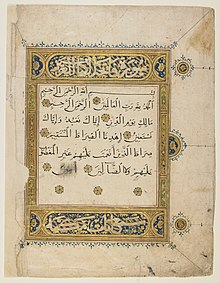Naskh (script)

| Part of a series on |
| Islamic culture |
|---|
| Architecture |
| Art |
| Clothing |
| Holidays |
| Literature |
| Music |
| Theatre |
Naskh (Arabic: نسخ nasḫ; also known as Naskhi or by its Turkish name Nesih) is a specific calligraphic style for writing in the Arabic alphabet, thought to be invented by the calligrapher Ibn Muqlah Shirazi (Arabic: ابن مقلهٔ). The root of this Arabic term nasakha (نسخ) means "to copy". It either refers to the fact that it replaced its predecessor, Kufic script, or that this style allows faster copying of texts. With small modifications, it is the style most commonly used for printing Arabic, Persian, Pashto and Sindhi languages.
This type of script was derived from Thuluth by introducing a number of modifications resulting in smaller size and greater delicacy. It is written using a small, very fine pen known as a cava pen, which makes the script eminently suitable for use in book production. Naskhi was used in copying Qur'ans,[1] Delails, En-ams and Hadiths. It was also used in commentaries on the Qur'an (Tefsir) and in collections of poetry (Divan). It was and is a very widely used form of script.
Naskh, along with Ta'liq, is also famous for giving rise to the Nasta'līq script, the script used for writing Urdu, Persian, Punjabi, Kashmiri, and sometimes Pashto and Uyghur.
Computers typically use Naskh or a Naskh-like script, for instance: بسم الله الرحمن الرحيم (the bismillah).
See also
References
- ^ "Qur'an Carpet Page; al-Fatihah". World Digital Library. Retrieved 28 February 2013.
